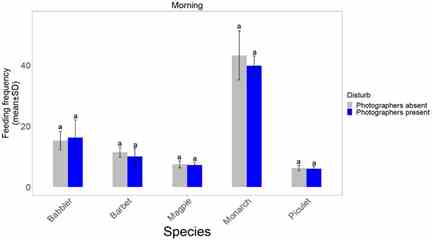Wildlife photography DOES impact birds’ breeding behaviour – but not in the way you might expect
Published 28 July, 2022
Capturing candid photos of birds in their natural habitat has become an increasingly popular activity globally. And photographing birds and their young in their nests offers photographers a fascinating glimpse into avian family life.
According to Xiaocai Tan, an ornithologist and PhD candidate at Guangxi University in China, this focus on birds’ nests has worried scientists, who are concerned that the close proximity of humans to the nesting sites might negatively impact bird reproduction.
However, in a study published in the KeAi journal Avian Research, she and her colleagues discovered that quite the opposite is true.
She explains: “Nonggang is a limestone tropical forest region in southern China. We noticed a sharp increase in the number of bird photographers visiting the area following the discovery of the Nonggang Babbler species there in 2008. These photographers were typically setting up their cameras close to the nests of a wide variety of bird species, as they knew that the parents would either be brooding their eggs, or returning to feed their young. This gave them the perfect opportunity to take great, and even award-winning photos.”
Tan and her colleagues decided to study the effect of these photographers on the birds’ nesting habits – specifically, nest predation and parental feeding rates. They knew that nest predators, including other birds, mammals and reptiles, were killing around 60%, and sometimes up to 75% of the ‘nestlings’ in the region, including the young of the globally vulnerable Nonggang Babbler.
During the study, which involved 12 months’ field work and the checking of 277 bird nests covering 42 species, the team discovered that the predation rate of nests that were photographed (13.3%), was signifantly lower than the rate seen in unphotographed nests (62.9%).
Tan adds: “In other words, the presence of the photographers increased the survival rate of the bird nestlings. Interestingly, their presence had little effect – positive or negative – on the feeding rates in those nests.”
According to Aiwu Jiang, the investigator who led the study, this finding is totally contrary to what most scientists had expected. He says: “Like a scarecrow, the presence of photographers seems to scare the nest predators away. Other research we’ve conducted in the same area shows that the presence of traffic noise can draw away birds’ mammalian predators.”
He adds: “Although this finding suggests that photograpy has a positive impact on the successful breeding of birds, it doesn’t mean that we are encouraging photographers to visit nest sites - there needs to be further assessment of other aspects of nesting, and other kinds of stress responses, before the total effect of bird photography can be understood.”

Image: The feeding frequency of five bird species in the morning with photographers absent (grey column) and present (blue column). CREDIT: Guangxi Key Laboratory of Forest Ecology and Conservation, Guangxi University, China.
###
Contact the corresponding author: Aiwu Jiang, aiwuu@163.com

